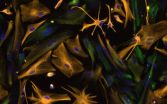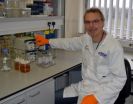(Press-News.org) Scientists are using powerful analytical and imaging tools to study artworks from all ages, delving deep below the surface to reveal the process and materials used by some of the world's greatest artists.
Northwestern University chemist Richard P. Van Duyne, in collaboration with conservation scientists at the Art Institute of Chicago, has been using a scientific method he discovered nearly four decades ago to investigate masterpieces by Pierre-Auguste Renoir, Winslow Homer and Mary Cassatt.
Van Duyne recently identified the chemical components of paint, now partially faded, used by Renoir in his oil painting "Madame Léon Clapisson." Van Duyne discovered the artist used carmine lake, a brilliant but light-sensitive red pigment, on this colorful canvas. The scientific investigation is the cornerstone of a new exhibition at the Art Institute of Chicago.
Van Duyne will discuss his research on Renoir's painting as well as his studies of Winslow Homer's watercolor "For to be a Farmer's Boy" and Mary Cassatt's pastel "Sketch of Margaret Sloane, Looking Right"at a Feb. 13 press briefing at the American Association for the Advancement of Science (AAAS) annual meeting in Chicago. The briefing, "Paintings: At and Under the Surface," will be held at 10 a.m. CST in Vevey Room 3 of the Swissôtel Chicago.
Van Duyne also will speak about "Detecting Organic Dyestuffs in Art with Surface-Enhanced Raman Spectroscopy" Friday, Feb. 14, at the AAAS meeting. His presentation is part of the symposium "Preserving Our Cultural Heritage: Science in the Service of Art" to be held from 10 to 11:30 a.m. CST in the Acapulco Room of the Hyatt Regency Chicago.
To see what the naked eye cannot see, Van Duyne used surface-enhanced Raman spectroscopy (SERS) to uncover details of Renoir's paint. SERS, discovered by Van Duyne in 1977, is widely recognized as the most sensitive form of spectroscopy capable of identifying molecules.
He is the Charles E. and Emma H. Morrison Professor of Chemistry in Northwestern's Weinberg College of Arts and Sciences.
Van Duyne and his colleagues' detective work informed the production of a new digital visualization of the painting's original colors by the Art Institute's conservation department. The re-colorized reproduction and the original painting (presented in a case that offers 360-degree views) can be viewed side by side at the exhibition "Renoir's True Colors: Science Solves a Mystery."
INFORMATION:
The show runs Feb. 12 through April 27 at the Art Institute of Chicago, 111 S. Michigan Ave. More information is available at http://www.artic.edu/exhibition/renoir-s-true-colors-science-solves-mystery.
Science is used to reveal masterpiece's true colors
Chemist uncovers paint details of Renoir masterpiece at Art Institute of Chicago
2014-02-13
ELSE PRESS RELEASES FROM THIS DATE:
Conservation science partnership thrives, expands
2014-02-13
For nearly a decade, Northwestern University and the Art Institute of Chicago have been partners in conservation science, unlocking secrets about many of the museum's masterpieces -- by Pierre-Auguste Renoir, Pablo Picasso, Henri Matisse, Winslow Homer, George Seurat, Mary Cassatt and others -- and developing new methods and technologies to investigate art.
Last year, a $2.5 million grant from the Andrew W. Mellon Foundation established the Northwestern University/Art Institute of Chicago Center for Scientific Studies in the Arts (NU-ACCESS), a new national model of ...
Protein switch dictates cellular fate: stem cell or neuron
2014-02-13
Researchers at the University of California, San Diego School of Medicine have discovered that a well-known protein has a new function: It acts in a biological circuit to determine whether an immature neural cell remains in a stem-like state or proceeds to become a functional neuron.
The findings, published in the February 13 online issue of Cell Reports, more fully illuminate a fundamental but still poorly understood cellular act – and may have significant implications for future development of new therapies for specific neurological disorders, including autism and ...
Marriage's 'haves' and 'have nots'
2014-02-13
EVANSTON, Ill. --- Today Americans are looking to their marriages to fulfill different goals than in the past — and although the fulfillment of these goals requires especially large investments of time and energy in the marital relationship, on average Americans are actually making smaller investments in their marital relationship than in the past, according to new research from Northwestern University.
Those conflicting realities don't bode well for the majority of marriages, according to Eli Finkel, professor of psychology in the Weinberg College of Arts and sciences ...
Why did the orangutan come down from the trees?
2014-02-13
Orang-utans come down from the trees and spend more time on the ground than previously realised – but this behaviour may be partly influenced by man, a new study has found.
Dr Mark Harrison, based in the Department of Geography at the University of Leicester and Managing Director of the Orang-utan Tropical Peatland Project (OuTrop) has, along with international colleagues, published results of a seven year study of orang-utans in Borneo in the journal Scientific Reports.
The research, conducted between June 2006 and March 2013, is based on a large-scale analysis of ...
Plants recycle too
2014-02-13
Cells communicate through proteins embedded in their cell membranes. These proteins have diverse functions and can be compared with antennas, switches and gates. For the well-being of the cell, it has to adjust the composition of its membrane proteins and lipids constantly. New proteins are incorporated, while old proteins get recycled or eliminated. The process by which membrane material gets internalized is called endocytosis. A research team headed by Daniël van Damme and Geert De Jaeger from VIB and Ghent University (Belgium), and Staffan Persson from the Max Planck ...
How bacteria communicate with us to build a special relationship
2014-02-13
Communication is vital to any successful relationship. Researchers from the Institute of Food Research and the University of East Anglia have discovered how the beneficial bacteria in our guts communicate with our own cells.
This is a key step in understanding how our bodies maintain a close relationship with the population of gut bacteria that plays crucial roles in maintaining our health, fighting infection and digesting our food.
A study, published in the journal Cell Reports, shows that the gut bacteria produce an enzyme that modifies signalling in cells lining the ...
Broad, MIT researchers reveal structure of key CRISPR complex
2014-02-13
Researchers from the Broad Institute and MIT have teamed up with colleagues from the University of Tokyo to form the first high definition picture of the Cas9 complex – a key part of the CRISPR-Cas system used by scientists as a genome-editing tool to silence genes and probe the biology of cells. Their findings, which are reported this week in Cell, are expected to help researchers refine and further engineer the tool to accelerate genomic research and bring the technology closer to use in the treatment of human genetic disease.
First discovered in bacteria in 1987, CRISPRs ...
Treating stroke with IV magnesium within an hour of symptoms fails to improve outcomes
2014-02-13
In the first study of its kind, a consortium led by UCLA physicians found that giving stroke patients intravenous magnesium within an hour of symptom onset does not improve stroke outcomes, according to research presented today at the American Stroke Association's International Stroke Conference.
However, the eight-year study found that, by working with paramedics in the field, intravenous medications can be given to stroke patients within the "golden hour," the window in which patients have the best chance to survive and avoid debilitating, long-term neurological damage. ...
Vitamin B12 accelerates worm development
2014-02-13
WORCESTER, MA – Everyday our cells take in nutrients from food and convert them into the building blocks that make life possible. However, it has been challenging to pinpoint exactly how a single nutrient or vitamin changes gene expression and physiology. Scientists at the University of Massachusetts Medical School have developed a novel interspecies model system that allows these questions to be answered. In a study appearing in the journal Cell, UMMS researchers use this new approach to show how bacterially supplied vitamin B12 changes gene expression, development and ...
Data links quick fix
2014-02-13
Software that can fix 90 percent of broken links in the web of data, assuming the resources are still on the site's server, has been developed by researchers in Iran. The details are reported this month in the International Journal Web Engineering and Technology.
Everyone knows the frustration of following a link to an interesting web site only to discover the target page is no longer there and to be presented with an error page. However, more frustrating and with wider implications for science, healthcare, industry and other areas is when machines communicate and expect ...
LAST 30 PRESS RELEASES:
Post-stroke injection protects the brain in preclinical study
Cardiovascular risk score predicts multiple eye diseases
Health: estimated one in ten British adults used or interested in GLP-1 medications for weight loss
Exercise to treat depression yields similar results to therapy
Whooping cough vaccination for pregnant women strengthens babies’ immune system
Dramatic decline in new cases of orphanhood in Uganda driven by HIV treatment and prevention programs
Stopping weight loss drugs linked to weight regain and reversal of heart health markers
Higher intake of food preservatives linked to increased cancer risk
Mass General Brigham–developed cholera vaccine completes phase 1 trial
First experimental validation of a “150-year-old chemical common sense” direct visualization of the molecular structural changes in the ultrafast anthracene [4+4] photocycloaddition reaction
Lack of support for people on weight loss drugs leaves them vulnerable to nutritional deficiencies, say experts
Dogs’ dinners can have greater climate impact than owners’
Are you ready to swap salmon for sprats and sardines?
1.6 million UK adults used weight loss drugs in past year
American College of Cardiology comments on new dietary guidelines for Americans
American Society of Gene & Cell Therapy and Orphan Therapeutics Accelerator partner to advance and commercialize promising rare disease treatments
One in 14 patients having day case surgery have new or worse chronic pain 3 months after their operation
New study highlights link between eviction rates and gun violence
Heatwaves heat up soil but not toxin levels in rice, study finds
Digital modeling reveals where construction carbon emissions really come from
Turning farm waste into water filters
New study shows how the spleen helps the immune system accept a transplant
New Mayo Clinic study advances personalized prostate cancer education with an EHR-integrated AI agent
Researchers identify novel therapeutic target to improve recovery after nerve injury
Microbes in breast milk help populate infant gut microbiomes
Reprogramming immunity to rewrite the story of Type 1 diabetes
New tool narrows the search for ideal material structures
Artificial saliva containing sugarcane protein helps protect the teeth of patients with head and neck cancer
Understanding the role of linear ubiquitination in T-tubule biogenesis
Researchers identify urban atmosphere as primary reservoir of microplastics
[Press-News.org] Science is used to reveal masterpiece's true colorsChemist uncovers paint details of Renoir masterpiece at Art Institute of Chicago



